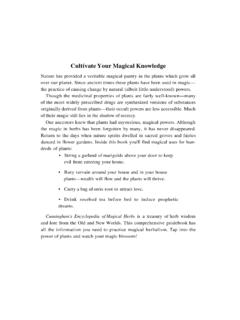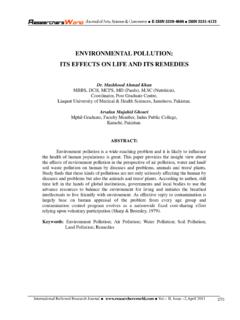Transcription of TOMATO Family: Solanaceae Genus: Solanum Scientific Name ...
1 TOMATO . Family: Solanaceae Genus: Solanum Scientific Name: Solanum lycopersicum Did you know the TOMATO has been called everything from the wolf peach, to Love Apple? The first from the botanical Latin name for the TOMATO plant, the last stemming from its botanical relation to the mandrake, or "love plant". As the TOMATO belongs to the Solanaceae family, known as the "deadly" Nightshade family, it has in the past given it a false reputation of being toxic while, in fact, it is the TOMATO leaf that is toxic and not the fruit or TOMATO . Botanical classification - In 1753 the TOMATO was placed in the genus Solanum by Linnaeus as Solanum lycopersicum L.
2 (derivation, 'lyco', wolf, plus 'persicum', peach, , "wolf-peach"). However, in 1768, Philip Miller placed it in its own genus, and he named it Lycopersicon esculentum. This name came into wide use, but was in breach of the plant naming rules. Technically the combination Lycopersicon lycopersicum (L.) H. Karst, would be correct, but this name (published in 1881) has hardly ever been used. Therefore it was decided to conserve the well-known Lycopersicon esculentum, making this the correct name for the TOMATO when it is placed in the genus Lycopersicon. However, genetic evidence ( Peralta & Spooner, 2001) has now shown that Linnaeus was correct in the placement of the TOMATO in the genus Solanum , making the Linnaean name correct; if Lycopersicon is excluded from Solanum , Solanum is left as a paraphyletic taxon.
3 Despite this, it is likely that the exact taxonomic placement of the TOMATO will be controversial for some time to come, with both names found in the literature. Fruit or vegetable? - Botanically speaking a TOMATO is the ovary, together with its seeds, of a flowering plant, a fruit. However, from a culinary perspective the TOMATO is typically served as a meal, or part of a main course of a meal, meaning that it would be considered a vegetable (a culinary term which has no botanical meaning). This argument has led to actual legal implications in the United States. In 1887, tariff laws which imposed a duty on vegetables but not on fruits caused the TOMATO 's status to become a matter of legal importance.
4 The Supreme Court settled this controversy in 1893, declaring that the TOMATO is a vegetable, using the popular definition which classifies vegetables by use, that they are generally served with dinner and not dessert. The case is known as Nix v. Hedden. It should be noted that strictly speaking the holding of the case applies only to the interpretation of the Tariff Act of March 3, 1883 and not much else. The court does not purport to reclassify TOMATO for botanical or for any other purpose other than paying a tax under a tariff act. In concordance with this classification, the TOMATO has been proposed as the state fruit of New Jersey.
5 In Europe the TOMATO is classified (correctly, botanically speaking) as a fruit. The TOMATO - The TOMATO ( Solanum lycopersicum) is a short- lived perennial plant, grown as an annual plant, in the Solanaceae or nightshade family, typically growing to 1-3 m tall, with a weakly woody stem that usually scrambles over other plants. The fruit is an edible, brightly colored (usually red, from the pigment lycopene) berry, 1-2 cm diameter in wild plants, commonly much larger in cultivated forms. Though it is botanically a berry, a subset of fruit, the TOMATO is nutritionally categorized as a vegetable.
6 The TOMATO is native to South America but growing in temperate climates worldwide. The TOMATO begins its colorful and varied history upon the coastal highlands of western South America, where it was being enjoyed by the native peoples for a long time. Evidence supports the theory that from Peru it found its way to Central America where it was domesticated as a little yellow fruit, called xitomatl', meaning plump thing with a navel , and later called 'tomatl' by other Mesoamerican peoples. Maya and other peoples in the region used the fruit in their cooking, and it was being cultivated in southern Mexico, and probably in other areas, by the 16th C.
7 It is thought that the Pueblo believed that those who witnessed the ingestion of TOMATO seeds were blessed with powers of divination. The large, lumpy TOMATO , a mutation from a smoother, smaller fruit, originated and was encouraged in Central America, the direct ancestor of some modern cultivated tomatoes. Unfortunately, much horticultural knowledge was lost after the arrival of Europeans, as the Roman Catholic Church had a policy of burning pre-Columbian information as pagan. Aztec mention tomatoes in various writings mentioning they were prepared with peppers, ground squash seeds, corn and salt, possibly the original salsa recipe, and were enjoying them when the Spanish conquistadors first came to the land.
8 This is where they were discovered by Cortez growing in Montezuma's gardens in 1519. After the Spanish conquest of South America, the Spanish distributed the TOMATO throughout their colonies in the Caribbean. They also brought it to the Philippines, from where it moved to Southeast Asia and then to the entire Asian continent. Of course, the Spanish also brought the TOMATO to Europe where it grew very easily in Mediterranean climates, and cultivation began there in the 1540s. It was probably eaten shortly after it was introduced, becoming a staple food of the poorer South of the Italian Peninsula, the Borbon state of Naples, where these new vegetables were embraced and cultivated as the peasant classes discovered that it could be eaten when more desirable food was scarce, while in other countries they were planted as ornamental curiosities, but not eaten: still today Italians are especially known for their love of the TOMATO .
9 This eventually developed into a whole cuisine of TOMATO dishes, as the wonders of the fruit became obvious, and the earliest discovered cookbook with TOMATO recipes was published in Naples in 1692. The TOMATO plant was not grown in England until the 1590s and one of the earliest cultivators was John Gerard, a barber-surgeon. Gerard's Herbal, published in 1597, and largely plagiarized from continental sources, is also one of the earliest discussions of the TOMATO in England. Gerard knew that the TOMATO was eaten in both Spain and Italy. Nonetheless, he believed that it was poisonous ( TOMATO leaves and stems are indeed poisonous in quantity, but the fruit is safe).
10 Gerard's views were influential, and the TOMATO was considered unfit for eating (though not necessarily poisonous) for many years in Britain and its North American colonies. By the mid 1700s, however, tomatoes were widely eaten in Britain, and before the end of that century the Encyclopedia Britannica stated that the TOMATO was "in daily use" in soups, broths, and as a garnish and reference to it can be found in the 1758 edition of Hannah Glasse's popular "The Art of Cookery". Tomatoes were originally known as 'Love Apples', possibly based on a mistranslation of the Italian name pomo d'oro (golden apple) as pomo d'amoro (amore really).



